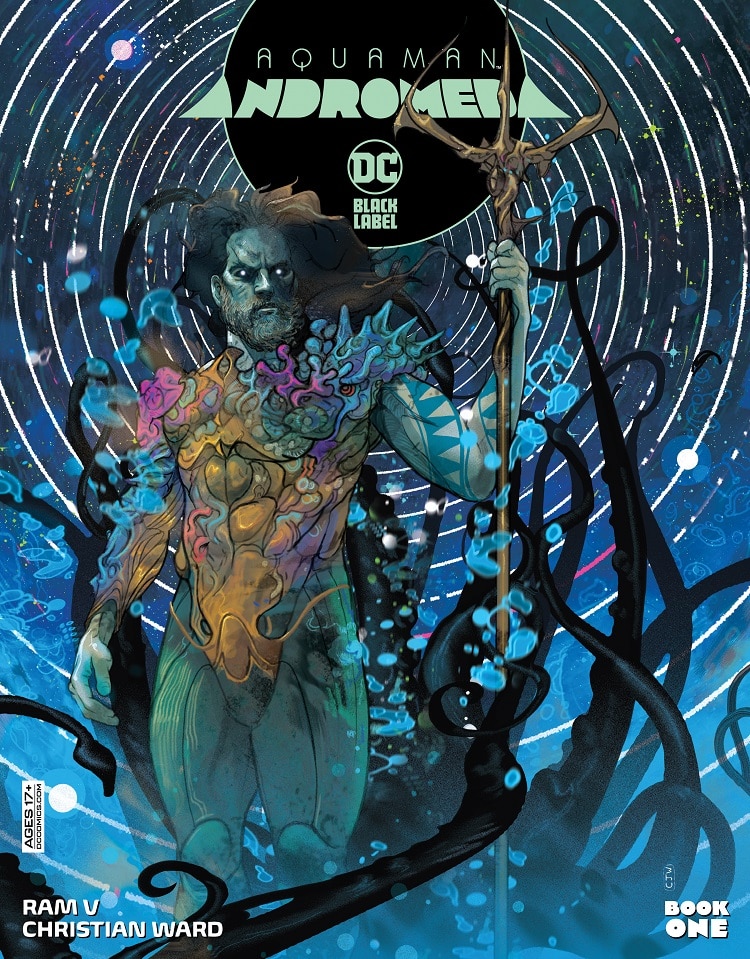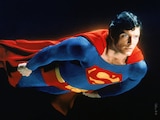Author of critically acclaimed and award-winning titles like These Savage Shores, Blue in Green and The Many Deaths of Laila Starr, DC’s history with Ram V started in 2018, with the writer demonstrating a deft skill at penning elaborate heists and horror-fueled supernatural adventures alike. With his now-beloved run on Catwoman and often frightening take on Justice League Dark, he’s kept us coming back for more—to the point that Ram now has an extended-by-demand Swamp Thing series, a mind-blowing DC Black Label Aquaman series, and will soon be taking the reins of DC’s longest running title, Detective Comics.
What exactly is his secret? Could it be that, as one of DC’s first Indian writers, he brings a unique cultural perspective rarely seen in mainstream western comics? Is it just an ingrained passion for the dramatic and macabre? Or is there something behind that V? We got right with Ram before the debut of his Detective turn to see if we could shake some answers loose.

Okay, let’s settle this in print, for everyone to see, once and for all. Is the V an initial, or is it a numeral?
The V is for Venkatesan, which is my father’s name. The south Indian naming convention, much like that in a lot of Nordic countries is first name + father’s name. My last name was tacked on as a matter of schooling convention in India.
When I first started writing, people would call me Mr. Venkatesan all the time. Which doesn’t really make sense given that it’s my father’s name. So, I went with Ram V.
I know Jamie Rich (my editor at the time) thought it was really cool to credit me as “V” on the covers, so it stuck! Had I known it would be the subject of eternal conversation, I’d have done it a long while back.
In The Swamp Thing, you introduced us to Levi Kamei, a new Swamp Thing and DC’s first lead South Asian character with a solo comic. Unlike his predecessor, Levi’s human form is a constant presence in this series, with his ability to switch back and forth between his “Swamp Self.” How important to the book is that choice?
I think that choice is pivotal to the story and character in a few ways. I’ve loved a lot of the runs on Swamp Thing that came before and it seemed pivotal in those runs that Swamp Thing was a creature contending with the afterimage of his humanity. In doing so, the stories commented on a character trying to retrieve the broken pieces of who he thought he was—Alec Holland.
With Levi, I wanted to bring in a protagonist who feels like he was a character of the here and now—of 2022 and in 2022. We are all everywhere people and we are nowhere people. Perennially stuck between identities—trying to be many different things at once in a world that keeps wanting to label you one way or the other.

I’ve had that experience in my life. Sometimes I’m Indian, sometimes I’m Asian, sometimes I am an immigrant, sometimes American (given the accent I picked up during my studies in Philadelphia) and sometimes I’m British (given where I live now).
These are all perceptions, but also fragmented pieces of an identity that is uniquely me. But they are fractious—they quarrel with each other, and I wanted to explore that with Levi. You can see he is all the things I mentioned above. But that is most dramatically and visually played out as a character who cannot control switching between his identities—human or monster, Levi or Swamp Thing, frightened innocent or superhero.
I think Levi is a truer representation of a kind of worldly, modern Asian that I hadn’t seen before in comics.
Your first Detective Comics arc, “Gotham Nocturne,” bills itself as a “Gothic Opera.” What makes a comic book operatic? Are these comics going to have those birthday card chips that sing at you when you open them?
I think there are a lot of interesting parallels between theatre and comics. And when I say “Gotham Nocturne” is going to be a “Gothic Opera,” I mean to say the comic will be infused with Gothic and Operatic aesthetics.

There are elements of noir, of tragedy, and the oppressive weight of a kind of brooding darkness that sits over everything. I think these “Gothic” elements are particularly apparent in the animated series and I wanted to bring some of that to the comic.
And then there is the high drama, the flourishes of acting, at times a little overblown, bordering on melodrama. Everyone is poignant, everything they say is poetic, lyrical and people seem to speak and act in ways that distill the dramatic elements of the narrative. To me, those are elements that feel Operatic.
I think both of these aesthetic influences work with Batman as a character and his stories as narrative. I’m very excited for people to see what we do with it, but I will say this—Detective will very much be a contemporary, quintessentially Batman story. It’s a balance and I’m having a lot of fun walking that tightrope.
As for the musical elements, you might not be too far off! I know there was some talk of a playlist and music being linked to the issues. So stay tuned!

I can’t help but notice that early sketches of “Gotham Nocturne” prominently feature Talia, one of the most important women in Batman’s life. Having spent a year with the other most important woman in Batman’s life, what’s the difference between his relationships with Talia and Catwoman?
A lot of this I want to explore in the story, of course. So, you’ll forgive me for being reserved with this answer.
With Selina, I always thought that the reason Batman is so fascinated with her is that she represents someone with a moral compass that is very seductive to Batman. If only he could stop caring so much about right and wrong. So, there is an allure, a temptation to bend rules in the pursuit of personal motives. Selina says to Batman—there is no moral code, only a moral compass whose needle shifts with each step you take.
In comparison, I think Talia pulls in the other direction. For her, Batman’s code is what she admires the most. The inflexible strength, the impossible determination of a man who chooses to be more. And yet, there is tragedy in that relationship. The very inflexibility she admires is the thing that keeps Batman and her apart. Their codes are different in important ways and with two characters who so strongly believe in their own ideas—the small differences are dramatic and existential.

It’s been said that a good comic book writer knows how to write to the strengths and interests of their artists. What are the strengths of the artists you work with now, and how do you indulge them?
I think we’ll be here forever if I begin to list the strengths of people like Mike Perkins, Rafael Albuquerque and Christian Ward. Not to mention my previous and continuing collaborators like Sumit Kumar, Anand RK and Evan Cagle. Let alone my colorists and letterers.
So, I think it would suffice to say, the key is to build collaborative relationships with your artists. Where the product is not one developed through “relay,” but through conversation. I’d like to think I have a strong visual sense when I script. And so, with Rafa for instance on Detective Comics, I know his ability to suggest tone and atmosphere using inks and shadows is tremendous and so I try to write scenes with that kind of setting, lighting and tenor.

Whereas with Mike, there is a fluidity married with intricacy in detail. It makes him near perfect for something organic yet detailed like The Swamp Thing.
With Christian on Aquaman: Andromeda, there is so much depth, elegance and grandeur to his work. I realize that the best approach there is to step back and give him room on the canvas.
I’d like to think all of these things show up on the page, but that the reader experiences the whole thing like a song and not as a bunch of musicians playing their individual pieces.
Let’s talk about Aquaman: Andromeda. The original myth of Andromeda is, rather appropriately for Aquaman, a story about a sea monster. But today, when people see “Andromeda,” they think cosmically, as in the Andromeda galaxy. What does the name mean to you?
I used the subtitle specifically because it had this duality of meaning. Andromeda, the original myth, is very much a story of the sea. But Andromeda as we perceive the word now immediately suggests space.
I wanted that to become the defining aesthetic of the book. We are very much in the sea, but traversing its depth is not unlike drifting into space. The unknown and the vastness of the ocean or of space as objects bears so much weight, and that is the kind of horror that excites me. Monsters and sea creatures and gross aliens are great, but truly exciting to me is the ability of concepts like emptiness, vastness and pressure to drive us mad. And by “mad,” I mean they skew and warp our perceptions of reality. The very foundations of what we know to be true start faltering in the face of the cosmic.

With nearly everything you’ve written for DC so far, you’ve introduced a new significant Middle Eastern or South Asian character. There’s the Swamp Thing himself, of course. In Catwoman, we met Wight Witch. In your Justice League Dark, you introduced us to Elnara Roshtu, the Eternal Knight. Can we anticipate some new important MESA characters in Aquaman: Andromeda and Detective Comics?
I’m so glad you (and readers) have noticed! It means a lot to me to make my stories feel like they truly encompass the truth of the world as I know it. I was born in India. I’ve lived half my life outside of it now and I’ve traveled a lot. I appreciate the universality of the human condition and love the differences and distinctions that make us all fascinating. When I was growing up, I never read stories with protagonists who came from the sort of place I came from and I think that is important—for readers and writers and artists to know that these stories are “their stories.”
So, I do try, where it works for the story, to introduce characters from different nationalities, cultures and locations. The crew in Aquaman: Andromeda is truly an international crew and as we’ll go on to see, their pasts, their cultures and backgrounds are reflected in their personalities and the baggage that they carry. In Detective, there are a fair few “new” characters being introduced and they are also from drastically different parts of the world.
I’m holding my tongue because I’d rather people discover these things on the page, but it’s very exciting and fulfilling to be writing these stories.
Detective Comics #1062, part one of “Gotham Nocturne,” is in stores and available digitally on Tuesday, July 26.
Aquaman: Andromeda #1 is now available in print and as a digital comic book.
The Swamp Thing is now available in print and to read on DC UNIVERSE INFINITE.




















